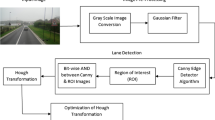Abstract
A new robust lane marking extraction algorithm for monocular vision is proposed based on Two-Dimension Declivity. It is designed for the urban roads with difficult conditions (shadow, high brightness, etc.). In this paper, we propose a locating system which, from an embedded camera, allows lateral positioning of a vehicle by detecting road markings. The primary contribution of the paper is that it supplies a robust method made up of six steps: (i) Image Pre-processing, (ii) Enhanced Declivity Operator (DE), (iii) Mathematical Morphology, (iv) Labeling, (v) Hough Transform and (vi) Line Segment Clustering. The experimental results have shown the high performance of our algorithm in various road scenes. This validation stage has been done with a sequence of simulated images. Results are very promising: more than 90% of marking lines are extracted for less than 12% of false alarm.
Access this chapter
Tax calculation will be finalised at checkout
Purchases are for personal use only
Similar content being viewed by others
References
Hwang, S., Kim, N., Choi, Y., Lee, S., Kweon, I.S.: Fast multiple objects detection and tracking fusing color camera and 3D LIDAR for intelligent vehicles. In: International Conference on Ubiquitous Robots and Ambient Intelligence (URAI), Sotitel Xian on Renmin Square, Xian, China, 19–22 August 2016
Yousif, T.M., Alharam, A.K., Elmedany, W., AlKhalaf, A.A., Fardan, Z.: GPRS-based robotic tracking system with real time video streaming. In: 4th International Conference on Future Internet of Things and Cloud Workshops, Vienna, Austria. IEEE (2016)
Xiaozhu, X., Cheng, H.: Object detection of armored vehicles based on deep learning in battlefield environment. In: 4th International Conference on Information Science and Control Engineering (ICISCE), Changsha, China, 21–23 July. IEEE (2017)
Saleem, N.H., Klette, R.: Accuracy of free-space detection: monocular versus binocular vision. In: International Conference on Image and Vision Computing New Zealand (IVCNZ), Palmerston North, New Zealand, 21–22 November. IEEE (2016)
Wedde, H.F., Senge, S.: BeeJamA: a distributed, self-adaptive vehicle routing guidance approach. IEEE Trans. Intell. Transp. Syst. 14(4), 1882–1895 (2013)
Magnier, V., Gruyer, D., Godelle, J.: Automotive LIDAR objects detection and classification algorithm using the belief theory. In: 2017 IEEE Intelligent Vehicles Symposium (IV), Redondo Beach, CA, USA, 11–14 June 2017
Nimvari, Z.E., Mosavi, M.R.: Accurate prediction of differential GPS corrections using fuzzy cognitive map. In: 3rd Iranian Conference on Signal Processing and Intelligent Systems (ICSPIS), 20–21 December 2017
Xu, F., Wang, Z.: An embedded visual SLAM algorithm based on Kinect and ORB features. In: Proceedings of the 34th Chinese Control Conference, Hangzhou, China, 28–30 July 2015
Chen, Y., He, M.: Sharp curve lane boundaries projective model and detection. In: 10th International Conference on Industrial Informatics (INDIN), Beijing, China, 25–27 July. IEEE (2012)
Basri, R., Rivlin, E., Shimshoni, I.: Image-based robot navigation under the perspective model. In: Proceedings of International Conference on Robotics and Automation, Detroit, MI, USA, 10–15 May 1999
Bali, A., Singh, S.N.: A review on the strategies and techniques of image segmentation. In: Fifth International Conference on Advanced Computing and Communication Technologies, Haryana, India, 21–22 February. IEEE (2015)
Kwon, D.: An image segmentation method based on improved watershed algorithm. In: International Conference on Computational and Information Sciences (ICCIS), Chengdu, China, 17–19 December. IEEE (2010)
Otsu, N.: A threshold selection method from gray-level histograms. IEEE Trans. Syst. Man Cybern. 9(1), 62–66 (1979)
Tang, G.: Road recognition and obstacle detection based on machine vision research, pp. 14–19 (2005)
Huang, J., Liang, H., Wang, Z., Mei, T., Song, Y.: Robust lane marking detection under different road conditions. In: International Conference on Robotics and Biomimetics (ROBIO), China, 12–14 December 2013. IEEE (2013)
Huang, J., Liang, H., Wang, Z., Song, Y., Deng, Y.: Lane marking detection based on adaptive threshold segmentation and road classification. In: Proceedings of the International Conference on Robotics and Biomimetics, 5–10 December 2014. IEEE (2014)
Michi, P., Debrie, R.: Fast and self-adaptive image segmentation using extended declivity. Ann. Télécommun. 50(3–4), 401 (1995)
Elhassouni, F., Ezzine, A., Alami, S.: Modelisation of raindrops based on declivity principle. In: 13th International Conference Computer Graphics, Imaging and Visualization (CGiV), 29 March–1 April 2016. IEEE (2016)
Yan, X., Li, Y.: A method of lane edge detection based on canny algorithm. In: Chinese Automation Congress (CAC), 20–22 October 2017
Jung, C.R., Kelber, C.R.: A robust linear-parabolic model for lane following. In: Proceedings of 17th Brazilian Symposium on Computer Graphics and Image Processing, pp. 72–77. IEEE (2004)
Takahashi, A., Ninomiya, Y., Ohta, M., Nishida, M., Yoshikawa, N.: Image processing technology for rear view camera (1): development of lane detection system. R&D Rev. Toyota CRDL 38(2), 31–36 (2003)
Niu, J., Lu, J., Xu, M., Lv, P., Zhao, X.: Robust lane detection using two-stage feature extraction with curve fitting. Pattern Recogn. 59, 225–233 (2016)
Author information
Authors and Affiliations
Corresponding author
Editor information
Editors and Affiliations
Rights and permissions
Copyright information
© 2018 Springer International Publishing AG, part of Springer Nature
About this paper
Cite this paper
Fakhfakh, M., Fakhfakh, N., Chaari, L. (2018). Robust Lane Extraction Using Two-Dimension Declivity. In: Rutkowski, L., Scherer, R., Korytkowski, M., Pedrycz, W., Tadeusiewicz, R., Zurada, J. (eds) Artificial Intelligence and Soft Computing. ICAISC 2018. Lecture Notes in Computer Science(), vol 10842. Springer, Cham. https://doi.org/10.1007/978-3-319-91262-2_2
Download citation
DOI: https://doi.org/10.1007/978-3-319-91262-2_2
Published:
Publisher Name: Springer, Cham
Print ISBN: 978-3-319-91261-5
Online ISBN: 978-3-319-91262-2
eBook Packages: Computer ScienceComputer Science (R0)




